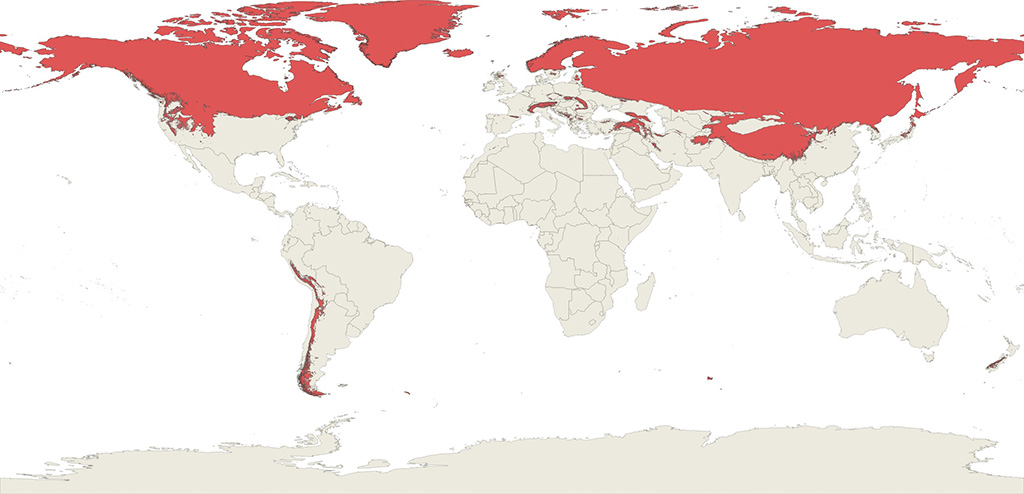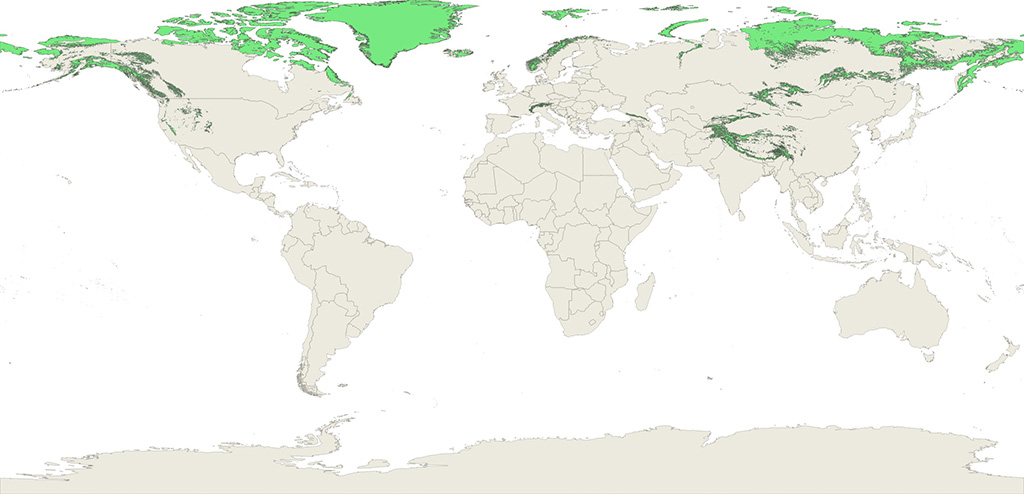Science and application opportunities for a dual-frequency Ku-band synthetic aperture radar concept - Call for ideas
On this page
- A dual Ku-band synthetic aperture radar concept dedicated to measuring terrestrial snow mass
- Motivation for a Call for Ideas
- Eligibility & deadline
- Type of responses
- Impact on primary mission objectives
- Call for Ideas terms
- How to submit your response
- Frequently Asked Questions (FAQ)
- Appendix A: Specifications of the dual-frequency Ku-band synthetic aperture radar concept
Publication date:
Application deadline:
A dual Ku-band synthetic aperture radar concept dedicated to measuring terrestrial snow mass
The Canadian Space Agency (CSA) completed the Phase 0 development for a moderate-resolution, dual-frequency Ku-band (13.5; 17.25 GHz) synthetic aperture radar (SAR) satellite concept. The initiative responds to a need identified by Environment and Climate Change Canada (ECCC) to increase Canada's capability to monitor snow water equivalent (SWE) over the Northern Hemisphere. The primary mission objective is to quantify the spatially and temporally dynamic amount of freshwater stored in seasonal terrestrial snow (the SWE); through data assimilation, improve the treatment of snow in operational environmental prediction systems and thereby enhance numerical weather prediction, hydrological forecasting, and seasonal prediction.
Motivation for a Call for Ideas
Should this dual Ku-band SAR concept be fully realized, the CSA would be interested in maximizing the science and socio-economical return on this mission. Notably, the SAR frequencies are a novel element of the mission that no other satellites historically or currently provide, which may enable new opportunities including the primary mission objectives. As such, the CSA would be interested in capturing the interest from the Canadian scientific community to pursue pre- and post-launch research investigations, including data validation activities, and innovative satellite data solutions development to help meet various needs in our everyday lives.
In the spirit of Reconciliation and the United Nations Declaration on the Rights of Indigenous Peoples, and in recognition of the value and importance of the science, technology and ways of knowing of Indigenous Peoples, the CSA is interested in hearing from Indigenous Peoples, who may wish to contribute Indigenous science or traditional knowledge through this Call for Ideas.
Eligibility & deadline
Any Canadian, Indigenous or International organization, industry, academic institution, government or non-government agency, consortium, or private citizen can submit a response to this Call for ideas. Please note that First Nation, Inuit and Métis Knowledge-keepers, Elders or other individuals who are the holders of Indigenous science and traditional knowledge, are invited to submit a response. Responses to this Call for ideas are not mandatory to be eligible to any subsequent call for opportunities.
All responses must be submitted to CSA before Midnight (ET) .
Type of responses
The CSA foresees four types of responses (or combinations thereof) to this Call for Ideas (responses provided should take into account the specifications provided in the Appendix A):
-
Additional science validation of primary mission algorithms and products:
Examples of potential needs for investment could include leveraging existing infrastructure and models to collect new data, perform additional analyses or refine models and algorithms to support the validation of the SWE, snow wet/dry state, and/or snow microstructure variables retrieved from dual Ku-band SAR data over a range of conditions and environments.
-
Additional variables retrieved from the concept as currently scoped:
Examples of potential needs for investments could include the retrieval of additional geophysical variables beyond the retrieval of snow-related variables, including validation activities. These activities could rely solely on data provided by the concept or also leverage other sources of data (in situ, airborne or satellite sensors).
-
Development of innovative applications towards ready-to-use products and services:
Examples of potential needs for investments could include the development of new applications, data products, models/prototypes, methodologies, teaching/learning methods and tools, education material, systems, services, etc. resulting from dual Ku-band SAR data to meet today's challenges resulting in a better future for all.
-
Suggested names for the concept as a future satellite mission
Impact on primary mission objectives
It should be noted that the primary objectives and corresponding measurement requirements of the dual-frequency Ku-band synthetic aperture radar concept are fixed, and that none of the ideas presented in response to this Call for Ideas shall conflict with the primary objective or add risk to the mission, should it be fully realized.
Call for Ideas terms
Information collected in this process is for planning purposes only and cannot be construed as intent to issue announcement of opportunities, grants or Request for Proposals (RFP) from the CSA. Responses will remain anonymous. All information provided in response to this Call for Ideas is non-binding.
This Call for Ideas shall in no way be considered as authorization by the CSA for respondents to undertake any work, which would result in costs to the CSA. The CSA shall not be liable for, nor shall it reimburse any respondents for, any costs, fees or expenses, which any respondent incurs in the preparation or submission of its response to this Call for Ideas.
The CSA does not intend to publicly disclose any proprietary or confidential information obtained during this Call for Ideas. To the full extent that it is protected pursuant to the Access to Information Act, any information identified by a respondent as "Proprietary" or "Confidential" will be kept confidential.
How to submit your response
Your Call for Ideas response shall be delivered by email to: systemeterre-earthsystem@asc-csa.gc.ca using the Response Submission Form . All communication regarding the content of this Call for Ideas and additional questions must be addressed to this address as well.
Frequently Asked Questions (FAQ)
-
Question 1: Is proof of Canadian citizenship, ownership or certification required to respond to this Call for ideas?
Answer 1: No. The information collected in this process is for planning purposes only and do not require proof of Canadian citizenship, ownership or certification.
-
Question 2: Can responses be submitted by individuals without an affiliation?
Answer 2: Yes, private citizens and organizations may submit a response. If submitting on behalf of an organization, the response must be approved by the Duly Authorized Representative of the specified organization.
Appendix A: Specifications of the dual-frequency Ku-band synthetic aperture radar concept
This appendix gives a description of the minimum requirements for the dual-frequency Ku-band synthetic aperture radar concept, as it is currently envisioned, for use in guiding proposals in response to this Call for Ideas.
| Science and Application Objectives | Scientific Measurement Requirements | Instrument Performance | General Requirements | |
|---|---|---|---|---|
| Physical Parameters | Inputs | |||
Snow Mass Inventory Hydrological Prediction Fate of Seasonal Snow Seasonal Prediction |
Snow Water Equivalent (SWE) Revisit: SWE Retrieval Accuracy (dry snow): Nominal Spatial Resolution Fine Spatial Resolution(Range × Azimuth): |
Ku-band backscatter C-Band backscatter:
Model outputs for:
|
Dual-frequency Ku-band backscatter: Looks: Incidence angle range: NESZ: Absolute Radiometric Accuracy: Radiometric Stability: |
Coverage: Duration: Latency: Nominal Resolution Geolocation: Fine Resolution Geolocation: Acquisition: Tasking: |
Snow State (wet/dry) Revisit: State Accuracy: Spatial Resolution: |
Ku-band backscatter | |||

Text version - Figure 1
World map with areas in red highlighting the areas that must be monitored by the Ku-band synthetic aperture radar concept, as a minimum, during the during the November-April period. These areas correspond to the non-ephemeral snow classes identified in the Global Seasonal-Snow Classification, Version 1 developed by Liston & Sturm ().
Figure 1. Minimum coverage during the November-April period. (Credit: CSA)

Text version - Figure 2
World map with areas in green highlighting the areas that must be monitored by the Ku-band synthetic aperture radar concept, as a minimum, during the during the May-October period. These areas correspond to the non-ephemeral snow classes identified in the Global Seasonal-Snow Classification, Version 1 developed by Liston & Sturm ().
Figure 2. Minimum coverage during the May-October period. (Credit: CSA)